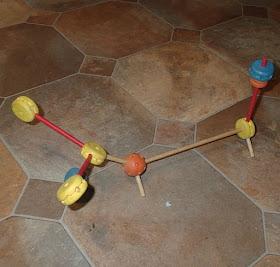 |
A Meccano gearing sampler which I showed to students at my son's school in about 2002 - potential knitting machine spares
|
 |
Some of Eddie's Meccano
|
 |
More Meccano ("Eddie's") and Meccano knockoffs ("mine")
|
 |
Mary, 2023
|
 |
Knitting machine before cleaning, 2023
|
 |
Knitting machine with Audax riders Alex McNee and Rodney Cruz, Cobram Hotel, 2023
|
 |
Christine Durbridge, Melbourne, 2023
|
 |
Mary, Christine, Geoff, 2015
|
 |
Knitting machine, Cobram, 2015
|
 |
Christine Nurse and Steve, 2015
|
 |
Knitting machine, Melbourne, 2023. The bearing circled in red is worn as detailed below.
|
 |
Bearing detail. It is a steel meccano rod in a bronze bracket, and the bronze has worn so the hole is about 1mm oversize. This has happened in a few places, and the brackets are loose on the baseboard as well.
|
 |
Artwork by Eddie. It is from a hand-wound machine - the closest thing we have today is Spirograph.
|
When I was very young, maybe 8 or 10 or so in the late 1960's, my family used to visit my great uncle (Dad's dad's brother) Eddie in Heathmont. Eddie was an inventor and chief amongst the inventions I remember was a "Spirograph" type machine, that is a mathematics - based drawing machine.
Spirograph has the artist moving cogs around pinned cogs to create patterns, however Eddie's machine was self contained with pattern variations programmed into the machine. The user just had to turn a handle and a pattern was created.
Another invention was a reflecting fireplace with a small central grate and reflective surrounds, and yet another was a solar energy collector which sloped down from the back wall of the house. Lastly, Eddie had made a water clock which now resides in the Melbourne Museum.
Eddie used everyday materials in his construction and this included Meccano. Somehow, I inherited some of Eddie's Meccano, and some of his tinkering and mechanical improvisation skills. The Meccano (a mix of Eddie's and mine) has sat idle on the top of a bookshelf for many years. But about 20 years ago I made toys demonstrating mechanical principles, and taught my son's primary school using them.
Really I had better stop rambling and get to the point! About 8 years ago, my wife Christine and I visited Moama for a holiday and drove on to Barooga during our stay, to visit my Aunt Mary (Eddie's daughter) and her husband Geoff. Time marches on, and now both Geoff and Christine are dead, Geoff dying in 2020, and Christine on October 9 2022. During that visit, Mary showed off her Dad's knitting machine - something I had never heard of - and I filmed it for youtube , photographed it, and put the results in a blog post.
Fast forward 8 years, and I was prompted by a facebook call to ride recumbents in a Cobram / Barooga Audax ride, a desire to visit my Aunt Mary again, and an email about the knitting machine video from Hilly Jacklin, a knitting machine enthusiast from the USA.
When I visited Cobram a few weeks later, I asked Mary if I could have the machine, and she readily agreed. We retrieved it from the top of a wardrobe. A few days later I had returned to Melbourne, cleaned it up, made a jig to carry it safely and shown it to my knitting friend Christine Durbridge.
Its now my ambition to get Eddie's knitting machine working again but there is no way I can do all the work myself. As per the photos, ideally the machine should be thoroughly cleaned and restored (bearing clearances reset) before attempting use, and I do not have the basic knitting knowledge to get the thing started.
I believe there'd have to be some sort of rod suspended above the machine onto which the knitting would be cast and then drawn upwards. Anyway, I'm putting it out there to a few contacts to see if I can get the restoration and reanimation started. Wish me luck!






























